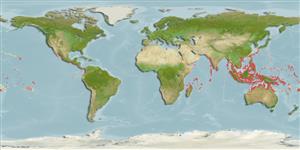Common names from other countries
>
Gobiiformes (Gobies) >
Gobiidae (Gobies) > Gobiinae
Etymology: Mahidolia: Named for His Royal Highness Prince Mahidol of Songkla, for his interest in the fishes and fisheries of Siam (Smith, 1932 original publication)..
More on author: Valenciennes.
Environment: milieu / climate zone / depth range / distribution range
Ecología
marino; salobre asociado a arrecife; rango de profundidad 5 - 20 m (Ref. 86942), usually 5 - 20 m (Ref. 37816). Tropical; 32°N - 20°S
Indo-Pacific: East Africa south to Delagoa Bay, Mozambique (Ref. 2798) and east to the Society Islands, north to southern Japan (?), south to northern Australia and Samoa.
Tamaño / Peso / Age
Maturity: Lm ? range ? - ? cm
Max length : 8.0 cm TL macho / no sexado; (Ref. 9710)
Short description
Claves de identificación | Morfología | Morfometría
Espinas dorsales (total) : 7; Radios blandos dorsales (total) : 10; Espinas anales: 1; Radios blandos anales: 9. Characterized by generally pale grey to yellowish body color; about six slightly diagonal bands on body; head with orange spots; usually with one or more black spots on first dorsal fin; variable coloration of fins; first dorsal fin, fan like; united pelvic fins, frenum present; longitudinal scale series 33-37; head without scales; greatest depth of body 3.9-4.4 in SL; rounded caudal fin, about equal to head length (Ref. 90102).
Occurs in silty coastal bays (Ref. 9710). Enters estuaries (Ref. 4343) and freshwater tidal zone habitats (Ref. 12693). Found on muddy bottom at the base of the reef at Toguan Bay, Guam. Uses the burrow of a mottled brown alpheid prawn with two or more short white saddles or spots. Lives coastal sand and mud habitats from shallow estuaries to moderate depths on slopes (Ref. 48637).
Life cycle and mating behavior
Maturities | Reproducción | Spawnings | Egg(s) | Fecundities | Larva
Myers, R.F., 1991. Micronesian reef fishes. Second Ed. Coral Graphics, Barrigada, Guam. 298 p. (Ref. 1602)
IUCN Red List Status (Ref. 130435)
CITES (Ref. 128078)
Not Evaluated
Threat to humans
Harmless
Human uses
Pesquerías: comercial; Acuario: Comercial
Herramientas
Special reports
Download XML
Fuentes de Internet
Estimates based on models
Preferred temperature (Ref.
115969): 25.9 - 29.1, mean 28.3 (based on 818 cells).
Phylogenetic diversity index (Ref.
82804): PD
50 = 1.0000 [Uniqueness, from 0.5 = low to 2.0 = high].
Bayesian length-weight: a=0.00708 (0.00333 - 0.01504), b=3.09 (2.92 - 3.26), in cm Total Length, based on LWR estimates for this (Sub)family-body shape (Ref.
93245).
Nivel trófico (Ref.
69278): 4.0 ±0.65 se; based on food items.
Resiliencia (Ref.
120179): Alto, población duplicada en un tiempo mínimo inferior a 15 meses (Preliminary K or Fecundity.).
Fishing Vulnerability (Ref.
59153): Low vulnerability (10 of 100).
